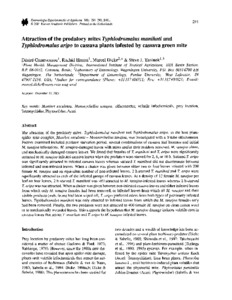| dc.contributor.author | Gnanvossou, D. |
| dc.contributor.author | Hanna, R. |
| dc.contributor.author | Dicke, M. |
| dc.contributor.author | Yaninek, S. |
| dc.date.accessioned | 2019-12-04T11:21:14Z |
| dc.date.available | 2019-12-04T11:21:14Z |
| dc.date.issued | 2001 |
| dc.identifier.citation | Gnanvossou, D., Hanna, R., Dicke, M. & Yaninek, S. (2001). Attraction of the predatory mites Typhlodromalus manihoti and Typhlodromalus aripo to cassava plants infested by cassava green mite. Entomologia Experimentalis et Applicata, 101, 291-298. |
| dc.identifier.uri | https://hdl.handle.net/20.500.12478/3718 |
| dc.description.abstract | The attraction of the predatory mites, Typhlodromalus manihoti and Typhlodromalus aripo, to the host plant-spider mite complex, Manihot esculenta–Mononychellus tanajoa, was investigated with a Y-tube olfactometer. Factors examined included predator starvation period, several combinations of cassava leaf biomass and initial M. tanajoa infestations, M. tanajoa-damaged leaves with mites and/or their residues removed, M. tanajoa alone, and mechanically damaged cassava leaves. We found that females of T. manihoti and T. aripo were significantly attracted to M. tanajoa-infested cassava leaves when the predators were starved for 2, 6, or 10 h. Satiated T. aripo was significantly attracted to infested cassava leaves whereas satiated T. manihoti did not discriminate between infested and non-infested leaves. When a choice was given between either two or four leaves infested with 200 female M. tanajoa and an equivalent number of non-infested leaves, 2 h-starved T. manihoti and T. aripo were significantly attracted to each of the infested groups of cassava leaves. At a density of 12 female M. tanajoa per leaf on four leaves, 2 h-starved T. manihoti was still attracted to M. tanajoa-infested leaves whereas 2 h-starved T. aripo was not attracted. When a choice was given between non-infested cassava leaves and either infested leaves from which only M. tanajoa females had been removed, or infested leaves from which all M. tanajoa and their visible products (web, feces) had been wiped off, T. aripo preferred odors from both types of previously infested leaves. Typhlodromalus manihoti was only attracted to infested leaves from which the M. tanajoa females only had been removed. Finally, the two predators were not attracted to 400 female M. tanajoa on clean cotton wool or to mechanically wounded leaves. This supports the hypothesis that M. tanajoa damage induces volatile cues in cassava leaves that attract T. manihoti and T. aripo to M. tanajoa-infested leaves. |
| dc.language.iso | en |
| dc.subject | Manihot Esculenta |
| dc.subject | Mononychellus Tanajoa |
| dc.subject | Olfactometer |
| dc.subject | Volatile Infochemicals |
| dc.subject | Prey Location |
| dc.subject | Tetranychidae |
| dc.subject | Phytoseiidae |
| dc.subject | Acari |
| dc.title | Attraction of the predatory mites Typhlodromalus manihot and Typhlodromalus aripo to cassava plants infested by cassava green mite |
| dc.type | Journal Article |
| dc.description.version | Peer Review |
| cg.contributor.affiliation | International Institute of Tropical Agriculture |
| cg.contributor.affiliation | Wageningen University and Research Centre |
| cg.contributor.affiliation | Purdue University |
| cg.coverage.region | Africa |
| cg.coverage.region | Acp |
| cg.coverage.region | West Africa |
| cg.coverage.region | Europe |
| cg.coverage.region | North America |
| cg.coverage.country | Benin |
| cg.coverage.country | Netherlands |
| cg.coverage.country | United States |
| cg.isijournal | ISI Journal |
| cg.authorship.types | CGIAR and advanced research institute |
| cg.iitasubject | Pests Of Plants |
| cg.iitasubject | Plant Breeding |
| cg.iitasubject | Plant Diseases |
| cg.iitasubject | Aflatoxin |
| cg.iitasubject | Agribusiness |
| cg.iitasubject | Cassava |
| cg.iitasubject | Livelihoods |
| cg.iitasubject | Farm Management |
| cg.iitasubject | Plant Health |
| cg.iitasubject | Plant Production |
| cg.accessibilitystatus | Limited Access |
| local.dspaceid | 95873 |
| cg.identifier.doi | https://doi.org/10.1046/j.1570-7458.2001.00914.x |

